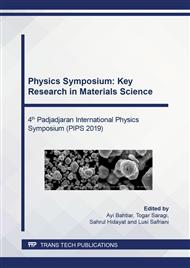[1]
L.F. Liotta, Catalytic oxidation of volatile organic compounds on supported noble metals, Appl. Catal. B Environ. 100 (2010) 403–412.
DOI: 10.1016/j.apcatb.2010.08.023
Google Scholar
[2]
M. Schwentenwein, J. Homa, Additive Manufacturing of Dense Alumina Ceramics, Int. J. Appl. Ceram. Technol. 12 (2015) 1–7.
DOI: 10.1111/ijac.12319
Google Scholar
[3]
H. Zhang, G. Shan, H. Liu, J. Xing, Preparation of (Ni/W)-γ-Al2O3 Microspheres and Their Application in Adsorption Desulfurization for Model Gasoline, Chem. Eng. Commun. 194 (2007) 938-945.
DOI: 10.1080/00986440701232387
Google Scholar
[4]
M.H. Atala, E. Gul, How to strengthen dental ceramics, Int. J. Dent. Sci. Res. 3 (2015) 24–27.
Google Scholar
[5]
S. Fujiwara, Y. Tamura, H. Maki, N. Azuma, Y. Takeuchi, Development of new high-purity alumina, Sumitomo Kagaku, 2007 (2007) 1-10.
Google Scholar
[6]
Y. Wang, Y. Xia, Bottom-up and top-down approaches to the synthesis of monodispersed spherical colloids of low melting-point metals, Nano Lett. 4 (2004) 2047–(2050).
DOI: 10.1021/nl048689j
Google Scholar
[7]
M. Farahmandjou, N. Golabiyan, New pore structure of nano-alumina (Al2O3) prepared by sol gel method, J. Ceram. Process. Res. 16 (2015) 1–4.
Google Scholar
[8]
T. Noguchi, K. Matsui, N.M. Islam, Y. Hakuta, H. Hayashi, Rapid synthesis of γ-Al2O3 nanoparticles in supercritical water by continuous hydrothermal flow reaction system, J. Supercrit. Fluids. 46 (2008) 129–136.
DOI: 10.1016/j.supflu.2008.04.011
Google Scholar
[9]
Y.R. Uhm, G.H. Lee, J.H. Park, W.W. Kim, C.K. Rhee, Study of phase transformation of nano Al2O3 compacts derived by hydrolysis and subsequent thermal sintering of Al powders, Mater. Sci. Forum. 449–452 (2004) 1129–1132.
DOI: 10.4028/www.scientific.net/msf.449-452.1129
Google Scholar
[10]
X.Y. Chen, Z.J. Zhang, X.L. Li, S.W. Lee, Controlled hydrothermal synthesis of colloidal boehmite (γ-AlOOH) nanorods and nanoflakes and their conversion into γ-Al2O3 nanocrystals, Solid State Commun. 145 (2008) 368–373.
DOI: 10.1016/j.ssc.2007.11.033
Google Scholar
[11]
J. Lee, H. Jeon, D. . Oh, J. Szanyi, J.H. Kwak, Morphology-dependent phase transformation of γ-Al2O3, Appl. Catal. Gen. 500 (2015) 58–68.
DOI: 10.1016/j.apcata.2015.03.040
Google Scholar
[12]
C.F.K. Murti, H. Aldila, Endarko, Triwikantoro, Particle size analysis of the synthesised ZrO2 from natural zircon sand with variation of pH deposition using alkali fusion-coprecipitation method, Mater. Sci. Forum. 966 (2019) 89–94.
DOI: 10.4028/www.scientific.net/msf.966.89
Google Scholar
[13]
U. Holzwarth, N. Gibson, The Scherrer equation versus the Debye-Scherrer equation,, Nat. Nanotechnol. 6 (2011) 534–534.
DOI: 10.1038/nnano.2011.145
Google Scholar
[14]
Musyarofah, N.D. Lestari, R. Nurlaila, N.F. Muwwaqor, Triwikantoro, S. Pratapa, Synthesis of high-purity zircon, zirconia, and silica nanopowders from local zircon sand, Ceram. Int. 45 (2019) 6639–6647.
DOI: 10.1016/j.ceramint.2018.12.152
Google Scholar
[15]
M. Abdullah, Derivation of scherrer relation using an approach, in: Basic Physics Course. 1 (2008) 1-5.
Google Scholar
[16]
M.T. Ravanchi, M.R. Fard, S. Fadaeerayeni, F. Yaripour, Effect of calcination conditions on crystalline structure and pore size distribution for a mesoporous alumina, Chem. Eng. Commun. 202 (2015) 493–499.
DOI: 10.1080/00986445.2013.850577
Google Scholar


